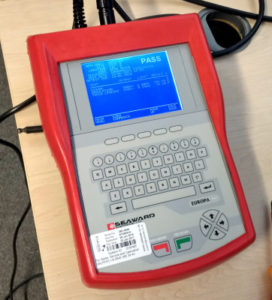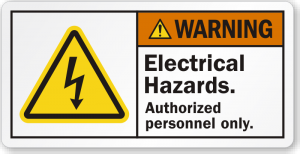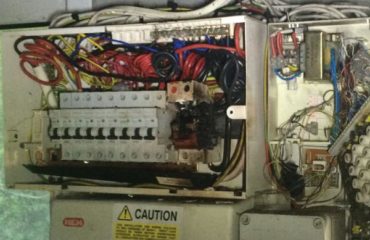 Everywhere we look in our everyday lives, from our bench to our bedroom, there are the ubiquitous electrical cords of mains-powered appliances. We don’t give our electrical devices a second thought, but in addition to their primary purpose they all perform the function of keeping us safe from the dangerous mains voltages delivered from our wall sockets.
Everywhere we look in our everyday lives, from our bench to our bedroom, there are the ubiquitous electrical cords of mains-powered appliances. We don’t give our electrical devices a second thought, but in addition to their primary purpose they all perform the function of keeping us safe from the dangerous mains voltages delivered from our wall sockets.
Of course, we’ve all had appliances that have become damaged. How often have you seen a plug held together with electrical tape, or a cord with some of its outer sheath missing? It’s something that we shouldn’t do, but it’s likely many readers are guiltily shuffling a particular piece of equipment out of the way now.
In most countries there are electrical regulations which impose some level of electrical safety on commercial premises. Under those regulations, all appliances must be regularly tested, and any appliances that fail the tests must be either repaired or taken out of service
In the United Kingdom,where this piece is being written, the law in question is the Electricity At Work Regulations 1989, which specifies the maintenance of electrical safety and that there should be evidence of regular maintenance of electrical appliances. It doesn’t specify how this should be done, but the way this is usually achieved is by a set of electrical tests whose official name: “In-service Inspection & Testing of Electrical Equipment”, isn’t very catchy. Thus “Portable Appliance Testing”, or PAT, is how the process is usually referred to. Join me after the break for an overview of the PAT system.
CONSIDER BOTH PHYSICAL AND ELECTRICAL
The PAT test has several parts, of which some are physical and some are electrical. A competent electrical engineer with a well-stocked bench could probably create a set-up to perform the electrical tests themselves, but for convenience and calibration they are invariably combined together in an application-specific self-contained unit, the PAT tester.
These instruments all perform substantially the same tests, but are available all the way from basic manual devices up to computerised machines with asset tagging and label printing. Once a test has been performed, the evidential part of the regulations is then usually satisfied by the application of a sticker with the test details. In most cases a green sticker for a pass, and a red one for a fail.
Astoundingly, there are installations in which this plug would work. Wrong polarity, earth instead of neutral, blown fuse replaced with foil. All testers will have seen plugs like this one.
The first part of a PAT test is always a visual one. Inspect the appliance, look for physical damage. Is there any point at which the protection between user and mains voltage has been compromised? Has the case been cracked or broken, or is there any way that something could be inserted to touch mains voltage? Then the power cord, has it been damaged, and is the plug in one piece? Has its strain relief been compromised? Open the plug up, and has it been wired incorrectly? If the answer is “yes” to any of those questions, then the appliance is instantly failed, or at least it must be repaired if that is possible before it can proceed to the electrical tests.
A final physical test for UK appliances concerns the fuse fitted in the plug. Our BS1363 plugs are unique in the world in having an inbuilt fuse, this is because our wiring topology means our sockets are capable of delivering more current than they are rated for. Thus our plugs have an inbuilt fuse whose purpose is simply to protect the appliance cable from fire in the event of a short circuit. The safety check is therefore twofold: that it has a correctly fitted fuse, and that the fuse current matches the rated current of the flex. Since our sockets are rated at 13A a lot of British plugs are supplied with a 13A fuse by default, so a significant part of a British PAT tester’s job involves levering out 13A fuses and replacing them with 3A, 5A, or 7A equivalents.
Arguments will no doubt rage in the comments about the merits of different world mains connector standards, but meanwhile most people involved in PAT testing here will have a significant surplus of 13A fuses. Do you have any project ideas for this windfall?
A BATTERY OF ELECTRICAL TESTS
Once the physical tests have been passed, it is time to turn to the PAT tester for the electrical tests. The computerised models will normally have a set of pre-programmed tests for different types of appliances rather than the physically selectable tests of the physical models, but the basic tests themselves are the same. There will be an earth bond test, an earth leakage test, and an insulation test.
A typical PAT tester
The earth bond test is for non double-insulated appliances, and ensures that the earth pin on the plug has a good quality connection to any exposed metal parts of the appliance. An earth bond lead from the tester is clipped to external metalwork, and a high DC current of about 40 A is passed between it and the earth pin on the socket. The aim of the test is to ensure that the earth connection has a suitably low resistance, and can take a high current without burning out.
The leakage test is designed to ensure that any leakage from the live supply to the earth wire or to the exposed metal parts of the appliance is at acceptably low levels. A low voltage AC is passed to the appliance, and the current returning down the appliance earth or the earth bond wire is measured to ensure that it is low enough to pass. Normally the pass figure is set in the order of one or two mA.
The insulation test applies a very high voltage, in the order of 500 V, to the appliance, and measures the insulation resistance, which should be in the very high M ohm range. This ensures that in the event of a high voltage transient spike there will be no breakdown and therefore no risk of shock to the user.
IN PLAIN SIGHT
These tests are vital to ensuring the unseen aspects of the appliance’s safety are in place and it does not pose a risk to its users. But it is worth remembering that they alone are only a part of the full battery of tests. When you have PAT tested a large number of appliances you will find that it is very rare to fail an appliance on the electrical tests, but very common to fail one on the visual inspection. So many power cords have rough lives and end up damaged, and so many appliances pick up knocks and scrapes that can expose the user to danger. It’s thus important to understand that the visual inspection is the most important part, and not owning a PAT tester does not mean that you are unable to ensure your appliances are safe.
What has been described here is based upon the appliance testing regime of just one country, but it should have universal application wherever in the world high voltage mains power is used. The prospect of electric shock or fire due to poor electrical wiring is something we can all face, so even if your country does not require any of these tests we’d still urge you to consider enacting something like them. When your inspections have found a sizeable heap of appliances in a lethal condition, you’ll probably be glad that you did.
Source: http://hackaday.com/2017/05/04/appliance-electrical-safety-testing-weve-got-it-down-pat/




